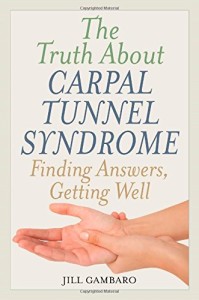Pain. The problem with pain is that everyone has a different threshold and there is no universal scale to measure pain. You can spot and gauge the pain associated with a grievous surface injury by depth or spread of the cut, number of broken bones or complete loss of movement. However, pain is, in a way, subjective. What I may feel 9 on the scale of 10, you might experience as 4. To make matters worse, there is no way your doctor can gauge the pain other than how you explain the intensity.
Because there is no visual cue, chronic pain is difficult to spot and treat. All that the doctor has is your description of the pain, where you think it originates, and what you experience causes it. For these reasons, people experiencing pain and specifically those who suffer Repetitive Strain Injuries need to be familiar with science of pain and basics of anatomy. The better you can explain your condition, the higher are the chances that your treatment will succeed.
Jill Gambaro has suffered Carpal Tunnel Syndrome and Radial Tunnel Syndrome for years. She experienced chronic pain at time when doctors had little scientific information on these ailments and were not sure how to treat these conditions. The muddy diagnoses and description of RSIs meant little support from Insurance companies and other legal safeguards like the Workers’ Compensation. Jill Gambaro waded through all these hurdles, met various medical specialists, consulted lawyers, and read through heaps of research to emerge through her RSIs.
 The Truth About Carpal Tunnel Syndrome: Finding Answers, Getting Well
The Truth About Carpal Tunnel Syndrome: Finding Answers, Getting Well
Author: Jill Gambaro Hardcover: 164 pages Publisher: Rowman & Littlefield Publishers (June 5, 2014) Language: English ISBN: 1442225793, 978-1442225794
In The Truth About Carpal Tunnel Syndrome, the author talks to all those who are diagnosed with Carpal Tunnel Syndrome and other similar RSIs and gives them the information they don’t know they need. A medical condition that is not yet completely defined creates much more problems than just the difficulty to diagnose and find a solution.
Many have found that a pain or disability that begins in the wrist can travel to the shoulder and beyond. A misdiagnosis or late compensation can delay correct treatment and exacerbate the injury that can invade other systems of your body and transform into nerve damage and eventually turn into permanent disability.
The author discusses all these different facets and what she learned through support groups and meeting Orthopedics, Massage Therapists, Yoga Instructors and legal experts to help her wade through the medical and legal factors associated with her Carpal Tunnel Syndrome.
Most RSI victims can feel alienated by others and family members who do not seem to believe that they are in pain. If a doctor cannot gauge your pain, it is infinitely more difficult for others to understand what you are experiencing when there is no visual damage. Chronic, repetitive pain only projects a picture of a chronic complainer and that doesn’t help the patient in any way.
The reader will find solace in authors’ words as she explains views on people on both sides and advises you with tips that worked for her. Above all, The Truth About carpal Tunnel Syndrome will prepare you for what is to come. If you are wearing that dreaded bracelet because your fingers are not printing the words that you are thinking, it is time to act and change.
Popping a pill and getting back to work can work for a few times, may be even years. But that doesn’t address the injury. Like Einstein says, It is insane to do the same thing again and again and expect a different result.
To make sure that you treat your RSI, it needs to be attacked on different fronts. And one of them is to change what you do. Either change the work that caused the injury, or the aspect of your work that contributed toward the injury. This could mean talking to an Ergonomics expert or a therapist and discuss the best way to relax your body during work and avoid posture and movements that caused the injury.
The Truth About Carpal Tunnel Syndrome talks of all these different approaches and the author shares various resources that the readers can use to get all the information they need to address their pain and injury. The author gives you alist of treatments that you can try, some helpful videos, people you can talk to, and products that will help you alleviate pain.